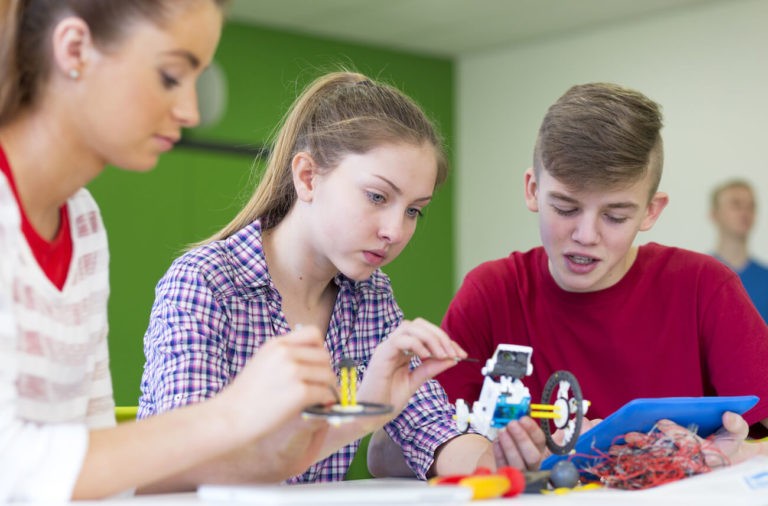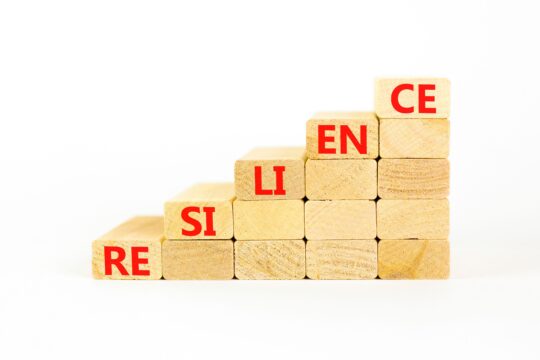As educators and leaders, we are always looking for ways to empower our students. We want them to be able to take the skills they learn in the classroom out into the “real world”, whether that is into their home, on the school bus, or in the workplace. After all, we know they are learning more than geometry proofs during class; they are learning about patience, endurance, and a growth mindset.
In junior high and high school, the focus on college and career readiness increases. Thanks to project-based learning, educators now have another tool to translate classroom experiences into the real world. If you currently don’t use project-based learning at your school or in your classroom, don’t feel overwhelmed at attempting to implement it with your students. A successful project-based learning experience requires some pre-planning on your part, but it is mostly facilitation and encouragement in the moment. Each project and each group of students will have different ideas and unique experiences, which is part of why project-based learning is so successful.
What is Project-Based Learning?
According to the Buck Institute for Education’s PBL Works, project-based learning, or PBL, is a teaching method that gives students the opportunity to learn by actively engaging in real world and personally meaningful projects. Educators pose students or groups of students with a complex task or question, and then encourage them to work on solving it for an extended period of time. PBL experiences can last for a few weeks or for the entire semester.
It’s important to distinguish that PBL experiences are different from other hands-on activities that you might plan to complement one particular lesson. Instead, PBL experiences are more complex and require students to actively work together, challenge one another, and learn together as they complete the task or answer the question posed at the beginning of the experience.
Benefits of Using PBL for College and Career Readiness
Project-based learning is successful because it naturally engages students throughout the entire process. Throughout their time working through a PBL experience, students gain and practice multiple skills they will use throughout their post-education world. Here are just a few benefits your students gain by participating, both passively and actively, in PBL projects.
Collaboration Comfort
One thing is certain in the workplace: teamwork is the foundation of a company’s success, no matter what industry the company is in. Unfortunately, students are not always comfortable with collaboration partially because typical group projects in the classroom do not allow for brainstorming, identifying experts in certain areas, or positive communication. Instead, traditional group projects end up with a leader (who is typically the most outgoing) and a group of reluctant followers who just want to get the project done with a good enough grade.
In contrast, project-based learning experiences are designed to enhance collaboration in a more positive way. Complex questions and problems require complex collaboration, meaning students must involve one another in order to capitalize on one another’s strengths. Students will learn the meaning of long-term collaboration, and those who tend to be more hesitant to contribute will become more comfortable with sharing their insight over time.
Flexibility and Change
It can be difficult to teach how to be flexible and adapt to change in the classroom, especially when the syllabus students receive is generally set in stone. However, flexibility and adaptability is required in the workforce and in college. PBL experiences give students the opportunity to practice this skill. Further, students who are not generally flexible or have perfectionist tendencies can learn by watching their peers who might be naturally more flexible.
Project-based learning experiences do not provide students with a straight line to the end of the project or answer. Instead, students will try new things or approaches and then evaluate what worked and what didn’t work before switching their tactic the next time around. Flexibility and adapting to change may not be there at the beginning of the project, but will surely be there by the conclusion.
Time and Project Management
In PBL experiences, students learn it isn’t just about turning in the final project one time. It’s about breaking down the project into bite size pieces spread out over time. This is a more complex way of looking at organization, and one that mirrors real world projects. Students will learn that their outcome will suffer with procrastination and will even discover the building blocks of work-life balance by spreading out milestones over the course of the experience.
PBL in Action
Project-based learning can be successful in any classroom, with any subject. As of a career and tech school, I have the opportunity to see PBL in action every day and how it works throughout a variety of industries and with a variety of student personalities.
One example of a project on our campus was with our Automotive Services program. Students were tasked with the long-term project of building a safety manual for their shop. They needed to review federal and state safety laws, as well as OSHA regulations to develop the start of their manual before turning to experienced shop owners to discuss other situations that pose a safety risk. Students also had to determine why a thorough safety manual was wise by evaluating how much workman’s compensation insurance and payouts can cost, and how that would affect their shop’s bottom line. Needless to say, students were well-versed in more than just OSHA precautions by the end of the project.
Other examples of project-based learning can include developing a seasonal menu, including pricing, for a restaurant that can bring the restaurant a profit, having students develop a plan for increasing voter registration in a certain area, or asking students to develop an app framework to increase positive communication between parents and the school. The opportunities are endless, as are the benefits to students.
How will you begin to implement PBL in your classroom or school?




